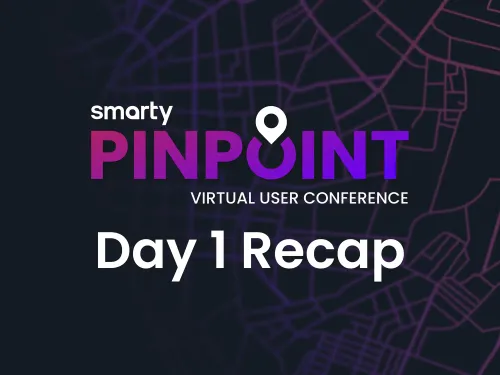Pinpoint 2025: Day 1 recap


For two days, Smarty users gathered together with other address data experts for Pinpoint, Smarty’s first virtual user conference, where developers, industry experts, and product specialists talked all things addresses and pulled back the curtain on address data solutions.
Attendees asked questions about cloud-based software, the impact of accurate address data on fintech and insurance companies, and the ROI of good address data across all industries.
Plus, attendees got to take a peek behind the scenes and see what makes Smarty’s address data solutions tick. And, of course, every session was topped off with a little Smarty fun!
Day 1 was jam-packed with awesome sessions, including:
- Welcome to Pinpoint: Kickoff from Smarty's CEO
- Creative—and a little creepy—developer hacks using address data
- Stripe spotlight: Driving growth with dynamic tax compliance
- Driving greater ROI with location-based risk modeling
- There's gold in them thar addresses: Transforming everyday address data into business results
- Master Smarty's autocomplete + verification
Welcome to Pinpoint: Kickoff from Smarty's CEO
Jonathan Oliver, CEO and Founder of Smarty, opened Pinpoint by sharing Uber’s reason for licensing address data from Smarty: we provide the precision they need for successful pickups and deliveries.
Utilizing his experience in software and distributed systems engineering, Jonathan provided a brief overview of the history of the cloud. The cloud provided companies with speed, scalability, and automation potential that on-premise software struggled to offer. However, the cloud brought a downside of its own—outages.
Ultimately, there are several main things that can be done to build your business to be more resilient to outages:
Identify single points of failure. Organizations need to understand where vulnerabilities exist, whether they’re as small as a single machine or as large as an entire cloud provider.
Chart dependencies. It's important to map out both application dependencies and cloud system dependencies, as a seemingly distributed system might depend on something that’s a single point of failure.
Limit blast radius. When failures occur, organizations should design systems to contain the impact rather than allowing failures to cascade across multiple services.
Run multiple instances across availability zones and regions. Instead of running a single application server, use multiple servers behind load balancers. For mission-critical applications, distribute across multiple cloud regions and ideally multiple cloud providers.
Use multi-cloud architecture. For applications where downtime costs significant money, running on multiple cloud providers simultaneously protects against provider-wide outages.
Implement abstraction layers. Rather than tightly coupling code to specific cloud provider APIs, create abstraction layers that allow applications to work across different providers.
Diversify DNS providers. Use multiple DNS providers so that if one goes offline, traffic can still be routed to your application.
Plan for known failure modes. Understand how specific systems fail and design accordingly—for example, using replication strategies to protect against storage failures.
Ask "what happens when?" The critical question to repeatedly ask is what happens when any given dependency goes offline, and then code for that scenario.
To dig deeper into cloud solutions, watch the full recording.
Creative—and a little creepy—developer hacks using address data
In conversation with Ryan Muir (Sr. Product Marketing Manager for geocoding/insurance), Software Engineer Easton Gibson created three wacky tools using US Street API, US Address Enrichment API, US Reverse Geocoding, and SmartyKey®, and broke down the code behind each one. These tools included:
- A SmartyKey®-powered mashup of Smarty APIs that measured the distance between an address and nearby risks associated with fire, water, earth, or air, then determined which element poses the highest expected annual loss
- An algorithm that estimated the dollar value of property damage if a meteorite were to hit any property…and the 10 properties closest to it
- A US Reverse Geocoding and US Property Data pairing that used a home address to reveal the names of surrounding homeowners
Check out the full recording to utilize these tools in your policy creation or prefilling processes.
Stripe spotlight: Driving growth with dynamic tax compliance
Ben Roden (Product Marketing Manager for enrichment/FinTech) and Erich Rentz (Lead on Tax Geography) discussed Smarty's partnership with Stripe, a leading payments and financial infrastructure company with the goal of increasing the GDP of the internet.
Erich explained, “Stripe Tax's goal is to unblock any tax compliance concerns and help our users to be able to be tax compliant.” As companies scale, compliance can become an obstacle that leads them to avoid selling in specific markets or fail to collect all the information they need.
Without understanding which taxing jurisdiction a sale falls under, companies can risk noncompliance. More often than not, ZIP Codes and city boundaries aren’t enough to determine these jurisdictions, as each state—in some cases, each county or city within a state—defines its own sales tax rules and laws.
That’s where Smarty comes into play.
Stripe’s dynamic tax calculator system is fueled by Smarty’s accurate address data. Erich explained, “Having good address data is key to making sure that we are going to have the right tax calculation.”
With good data, Stripe Tax removes barriers to growth and market expansion to ensure a company’s “great idea isn’t stymied by the complexity of sales tax.”
Learn more about Stripe’s experience (and Erich’s love of maps 😉) in the full recording.
Driving greater ROI with location-based risk modeling
Product Marketing Managers Ryan Muir and Ben Roden explored how hyper-accurate address data can benefit insurance companies.
To simplify risk assessment and claims processing, Smarty has integrated with Guidewire and provides 13 accelerators spanning across PolicyCenter, ClaimCenter, and InsuranceNow.
To further empower risk modeling, Smarty provides insurers with access to location data. Rooftop-level geocoding can identify properties down to the suite level, so underwriters can assign risk models with high accuracy.
To maintain data accuracy when blending data for risk models, SmartyKey® ties the physical location of properties to a persistent, unique address identifier, rather than addresses, which are subject to change.
Our Product Marketing Managers showed users how Rooftop-level geocoding also heightens underwriting accuracy. With geocodes identifying the exact location of potential risks and insured properties, underwriters can calculate the precise distance between the two and price policies accordingly.
Additionally, Smarty’s US Property Data improves customer experience by enabling prefilling. Using an address entered by a potential customer, US Property Data can provide data points from property records, meaning customers spend less time applying, and underwriters spend less time verifying the accuracy of an application.
Watch the full recording to power up your risk modeling.
There's gold in them thar addresses: Transforming everyday address data into business results
To start off this session, Mike Allen (Customer Success Director) recounted the address-data journeys of five companies.
With rooftop-level geocoding, Hippo increased the accuracy of their risk modeling to improve reinsurance pricing, which will pay off in long-term savings. With address autocomplete, Fabletics increased order completions by 15%! 🤯
Both A local last-mile delivery company and Maven One Health utilized the speed and accuracy of address validation to provide their customers with better solutions. While HighlanderTek improved their shipping cost estimates and driver routing, Maven One Health increased the accuracy of their provider data.
Lightstream put Smarty’s US Street API cleansing service to work to reduce their onsite service times and increase customer satisfaction.
Next, John Hickey (Senior Product Marketing Manager) highlighted the 55 metadata points Smarty offers. He showed how metadata points can be used to reduce mail postage and shipping fees, detect fraud, conduct geospatial analysis mapping, comply with reporting requirements, optimize operations, segment databases, and blend data.
Marc Hansen (Enterprise Account Executive) finished off the session by describing an underutilized way to leverage Smarty’s enrichment data. With enrichment data, companies can uncover unexpected relationships and reverse-engineer their ideal customer profiles to market more effectively.
Ready to get the most out of your address data? The full recording is ready for you.
Master Smarty's autocomplete + verification
Software engineers Easton Gibson and Camí Blanch teamed up with Product Marketing Manager Kajsia McCoy to highlight the pairing of address autocomplete and verification.
Address autocomplete and address verification work together to enhance customer experience. In real-time, the products work together. Autocomplete suggests addresses in a drop-down to speed up checkout, and verification fixes any mistakes that might have snuck in from manual bypasses.
Plus, users get up to 55 metadata points per address. Companies can customize checkout forms with autocomplete and verification to set precise configuration parameters, including:
- The number of keystrokes before an API call
- Restrict address suggestions to a specific area (within a city, state, etc.)
- The type of addresses displayed (semi-valid addresses, non-postals, etc.)
- Presentation of secondary addresses
When setting up the backend of a checkout form equipped with autocomplete and verification, there are additional parameters to customize. You could:
- Activate component analysis (available with US Address Verification), a tool that pinpoints exactly which part of an address is invalid and why certain components were changed.
- Run bulk or single address lookups
- Utilize different geocode licenses (available with Geocoding products)
- Submit an address for verification at entry or order completion
For example, in their autocomplete-and-verification-powered checkout forms, Fabletics submits addresses for verification once users select an address from the dropdown provided by autocomplete, instead of waiting for users to submit their order. This way, Fabletics avoids issues caused by undeliverable addresses.
See the full recording to unlock the reduced costs, reliable data, and peace of mind that come with autocomplete and verification.
Conclusion
Whether you watched our event live or on demand, thank you for joining us! We’re also especially grateful to the partnerships that helped us take Day 1 to the next level!
If you enjoyed these sessions, you’re in luck. Pinpoint didn’t end there; we kept dropping address-data knowledge on Day 2. Check it out!


